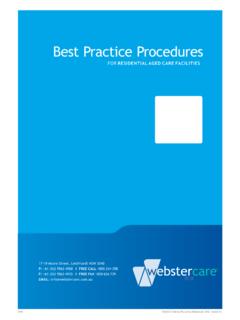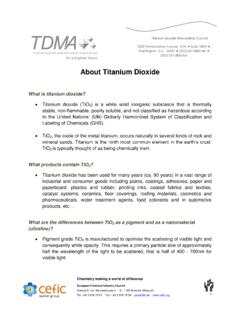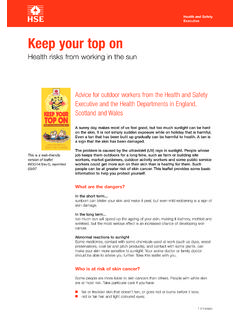Transcription of DRUG-INDUCED PHOTOSENSITIVITY S - Webstercare
1 MARCH 2015. DRUG-INDUCED PHOTOSENSITIVITY . S ome medicines can make people sensitive in sunscreens, and topical anti-inflammatory drugs. to sun exposure. This is called DRUG-INDUCED Most oral medicines causing photoallergy also cause PHOTOSENSITIVITY . DRUG-INDUCED PHOTOSENSITIVITY phototoxicity. or photosensitising medications can cause unexpected sunburn or a dry, bumpy or blistering rash on sun- An itchy-type reaction resembling eczema or allergic exposed skin (face, neck, arms, backs of hands and contact dermatitis occurs 24 to 72 hours after often lower legs and feet). The rash may or may not exposure to the sunlight and medicine. The rash may be itchy. spread to unexposed areas, and may be severe and prolonged. This reaction does not appear to be DRUG-INDUCED PHOTOSENSITIVITY occurs when a medicine dose-related. combines with UV radiation to cause a phototoxic or photoallergic reaction.
2 UV-A wavelengths are more Medications suspected of causing photoallergic drug likely to cause the reaction than UV-B wavelengths. reactions should be discontinued, as even minimal It is not always the bright summer sun which is amounts of further sun exposure can lead to reactions responsible; some people also react to sunlight in of increasing severity. winter, and very sensitive people may even be affected by fluorescent lamps indoors. Common photosensitising medications More than 300 drugs are associated with This adverse reaction may increase the incidence of PHOTOSENSITIVITY . Common photosensitising skin cancer and can be prevented with appropriate medications include: management. Antibiotics NSAIDs ( ibuprofen, naproxen, ketoprofen, Phototoxic reactions celecoxib). Phototoxic reactions result from direct damage to Diuretics (frusemide, bumetanide, tissue caused by light activation, occurring within hydrochlorothiazide).
3 Minutes to hours after exposure. The rash appears as Retinoids ( isotretinoin, acitretin). exaggerated sunburn with immediate reddening and Antifungals ( griseofulvin, voriconazole). swelling, which may or may not be itchy. Blisters and Hypoglycaemics (sulfonylureas). vesicles can occur in severe reactions. The reaction is Neuroleptics (chlorpromazine, fluphenazine, limited to sun-exposed skin and appears to be olanzapine, trifluoperazine). dose-related. Amiodarone Azathioprine Complications of repeated phototoxic injury include Diltiazem premature skin ageing and increased risk of skin Quinine cancer. Hyperpigmentation may remain after other Quinidine symptoms have resolved. Hydroxychloroquine In most cases of phototoxic drug eruption it is not Enalapril necessary to stop the medication provided protection Dapsone from the sun is possible. 5-fluorouracil Coal tar Photoallergic reactions St John's wort Photoallergic reactions are immune-mediated responses and are less common than phototoxic Sunscreens, fragrances, and occasionally soaps may reactions.
4 This type of PHOTOSENSITIVITY is more cause photoallergic reactions. relevant to topical agents, such as ultraviolet filters DRUG-INDUCED PHOTOSENSITIVITY . Quinolones, chlorpromazine, amiodarone, thiazide eczematous PHOTOSENSITIVITY that can last months diuretics, quinine, doxycycline and voriconazole after discontinuation of the drug . PHOTOSENSITIVITY reactions appear like sunburn. Statins (atorvastatin, fluvastatin, pravastatin, PHOTOSENSITIVITY reactions with naproxen, amiodarone, simvastatin) are known to cause both phototoxic quinolone antibiotics and voriconazole may cause reactions and photoallergic reactions. increased skin fragility and blistering. Calcium channel Sulfonylureas, used in the management of type 2. blockers may cause telangiectasia or small dilated diabetes mellitus, only cause photoallergic reactions. blood vessels near the surface of the skin (spider Voriconazole, an antifungal agent, is associated with veins).
5 An increased risk of skin cancer. The changes that occur with long-term exposure resemble accelerated Amiodarone and chlorpromazine reactions usually photo-aging. present with prickling or burning during exposure, and sometimes immediate redness (erythema), with Management oedema and urticaria with higher doses. The main management goal is to avoid photosensitising medicines. Patient education is Distinctive blue-grey pigmentation is associated important. If avoidance is not appropriate, sun with amiodarone phototoxic reactions. Incidence protection strategies must be followed. Sunscreens of PHOTOSENSITIVITY with amiodarone is common and protective clothing should be used. occurring in up to 30 to 50 % of people prescribed Pharmacists apply a cautionary advisory label the antiarrhythmic. Light sensitivity may persist for to medicines known to cause DRUG-INDUCED up to 4 months after the drug is stopped.
6 Cutaneous PHOTOSENSITIVITY : Avoid excessive skin exposure to pigmentation slowly fades after amiodarone is sunlight and sunlamps while being treated with this stopped, but may persist for months to years. The medicine. problem is related to both the dosage and the duration of drug therapy. Amiodarone is frequently commenced A mild phototoxic reaction typically resolves without at a high dose in hospital, where sun exposure is treatment and can be managed the same as sunburn, limited. Therefore it is important the resident is with analgesics, cooling creams or gels. Severe protected from sun exposure when admitted or reactions may require oral or topical corticosteroids. returning to aged care. Oral antihistamines have limited use for itch. Calamine lotion must be avoided as it is very drying to the skin. Chlorpromazine (Largactil) is the most common phenothiazine antipsychotic agent to cause immediate Summary PHOTOSENSITIVITY reactions, with an incidence of 2% to PHOTOSENSITIVITY reactions can occur when sunlight 3% when administered in high doses.
7 The reaction is or artificial forms of radiation interact with some characterised by a burning, painful erythema within commonly prescribed topical or systemic medications. minutes of exposure to sunlight, either directly or Phototoxic reactions tend to be more common and through windowpanes. The redness may persist for resemble severe sunburn. Their onset can be rapid. more than 24 hours. Occasionally, a golden-brown or Photo-allergic reactions tend to resemble allergic slate-grey pigmentation, predominantly of exposed contact dermatitis and they can have delayed onset. areas, may be seen. Avoidance of the causative agent is recommended, or if not appropriate, sun protection strategies should be Several antibiotic classes commonly cause used whilst taking the medicine. PHOTOSENSITIVITY , including tetracyclines (doxycycline), quinolones (ciprofloxacin, norfloxacin), and Further information available at: sulphonamides (trimethoprim/sulfamethoxazole, topics/how-to-be-medicinewise/Medicinewi se-questions/.)
8 Sulfasalazine). The tetracycline minocycline is not medicinewise-questions/medicines-and-sun -sensitivity generally associated with PHOTOSENSITIVITY . References Nearly all NSAIDs have been shown to cause inflammation when combined with UV radiation. Piroxicam and naproxen are the most frequently reported; whilst ibuprofen is not generally considered a culprit drug . PHOTOSENSITIVITY with frusemide generally occurs with very high doses in people with chronic kidney disease. Hydrochlorothiazide may cause chronic Manrex Pty Ltd (ABN 63 074 388 088) t/as Webstercare - 2015 Webstercare and The W Device are Registered Trade Marks of Manrex Pty Ltd t/as Webstercare .











